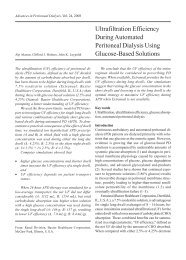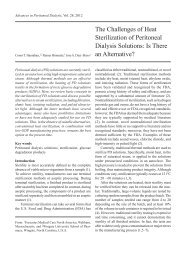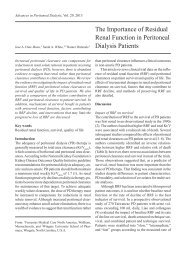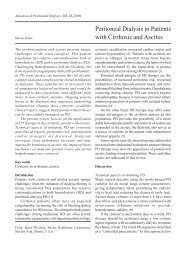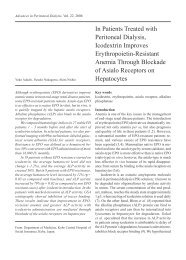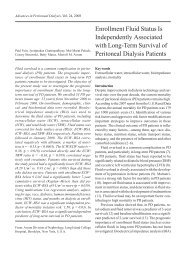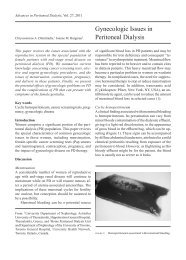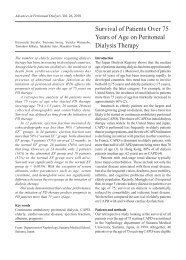Combined Amino-Acid and Glucose Peritoneal Dialysis Solution for ...
Combined Amino-Acid and Glucose Peritoneal Dialysis Solution for ...
Combined Amino-Acid and Glucose Peritoneal Dialysis Solution for ...
- No tags were found...
Create successful ePaper yourself
Turn your PDF publications into a flip-book with our unique Google optimized e-Paper software.
V<strong>and</strong>e Walle et al.229Soon after the introduction of Nutrineal, thosetheoretical considerations were already documentedin clinical practice. Indeed, in almost all of the studieson the use of intraperitoneal AAs, a significantincrease in serum levels of urea were reported, suggestingunsatisfactory utilization of the infused AAs(11,12). Moreover, it is well known that, without anenergy source, nitrogen will not be effectively incorporatedinto proteins.In parenteral nutrition, the combined infusion ofnon protein calories <strong>and</strong> AAs has been a key factorin ensuring the optimal utilization of the AAs. Totalparenteral nutrition (TPN) solutions with a ratio of150:1 (non protein calories to nitrogen) are consideredappropriate <strong>for</strong> most patients to incorporate deliveredAAs into new proteins. A mixture of Nutrineal<strong>and</strong> Dianeal simultaneously achieves three conditionsfavorable <strong>for</strong> protein synthesis: hyperinsulinemia,hyperaminoacidemia, <strong>and</strong> an adequate ratio of nonprotein calories to nitrogen (absorbed glucose toAAs).These considerations are of even more importancein intensive care units, where most patients are catabolic,lack enteral nutrition, <strong>and</strong> require ultrafiltration<strong>for</strong> every parenteral milliliter administered. The useof combined glucose–AA solutions in a peritoneumwith hyperemic dilated vessels will result in significantperitoneal resorption. That resorption may meeta significant percentage of the patient’s nutritionalneeds (AAs <strong>and</strong> glucose), limiting the need <strong>for</strong> intravenousadministration of TPN. Limiting intravenousfluid administration helps to eliminate the need <strong>for</strong>ultrafiltration by dialysis.In children in intensive care, who are often alreadyvery sensitive, an AA-containing mixture may helpto control glycemia, subsequently reducing the need<strong>for</strong> insulin. Our data demonstrate that the calculatedpercentage reabsorption of glucose <strong>and</strong> AAs is high<strong>and</strong> that plasma AA levels remain stable. The reabsorptiondata are comparable with data reported byCanepa et al. <strong>and</strong> Qamar et al. (13–17).Adequate protein <strong>and</strong> energy intake are essentialto the maintenance of nitrogen balance <strong>and</strong> the preventionof malnutrition in intensive care. Treatmentwith oral calorie <strong>and</strong> protein supplements is oftenimpossible, but intravenous administration of TPN isoften limited by the excessive fluid load imposed on apatient in anuria by the need to reach a given nutritionaltarget. The use of AA-based dialysis fluid combinedwith glucose may provide opportunities to compensate<strong>for</strong> dialytic losses of protein <strong>and</strong> AAs <strong>and</strong> tosupplement inadequate dietary protein intake, withsubsequent improvement in nutritional status, becauseof the resulting anabolic benefit <strong>and</strong> limitation of unnecessaryAA metabolism.ConclusionsAlthough our data do not demonstrate a potential influenceon final outcome, they demonstrate the feasibility<strong>and</strong> safety of using combined AA–glucosesolution, with a calculated resorption that lends nutritionalsupport.References1 Strazdins V, Watson AR, Harvey AR. Renal replacementtherapy <strong>for</strong> acute renal failure in children: Europeanguidelines. Pediatr Nephrol 2004; 19:199–207.2 Schroder CH <strong>and</strong> the European Paediatric <strong>Peritoneal</strong><strong>Dialysis</strong> Working Group. The choice of dialysis solutionsin pediatric chronic peritoneal dialysis: guidelinesby an ad hoc European committee. Perit Dial Int2001; 21:568–74.3 Kopple JD, Bernard D, Messana J, et al. Treatment ofmalnourished CAPD patients with an amino acidbased dialysate. Kidney Int 1995; 47:1148–57.4 Coleman JE, Watson AR, Rance CH, Moore E. Gastrostomybuttons <strong>for</strong> nutritional support on chronicdialysis. Nephrol Dial Transplant 1998; 13:2041–6.5 Flynn JT, Kershaw DB, Smoyer WE, Brophy PD,McBryde KD, Bunchman TE. <strong>Peritoneal</strong> dialysis <strong>for</strong>management of pediatric acute renal failure. PeritDial Int 2001; 21:390–4.6 V<strong>and</strong>e Walle J, Raes A, Castillo D, Lutz–Dettinger N,Dejaegher A. New perspectives <strong>for</strong> PD in acute renalfailure related to new catheter techniques <strong>and</strong> introductionof APD. Adv Perit Dial 1997; 13:190–4.7 V<strong>and</strong>e Walle J, Raes A, Castillo D, Lutz–Dettinger N,Dejaegher A. Advantages of HCO 3solution with lowsodium concentration over st<strong>and</strong>ard lactate solutions<strong>for</strong> acute peritoneal dialysis. Adv Perit Dial 1997; 13:179–82.8 Goldstein SL. Overview of pediatric renal replacementtherapy in acute renal failure. Artif Organs2003; 27:781–5.9 Maxvold NJ, Smoyer WE, Gardner JJ, BunchmanTE. Management of acute renal failure in the pediatricpatient: hemofiltration versus hemodialysis. Am JKidney Dis 1997; 30(Suppl 4):S84–8.10 Symons JM, Brophy PD, Gregory MJ, et al. Continuousrenal replacement therapy in children up to10 kg. Am J Kidney Dis 2003; 41:984–9.



